FIAT 500L 2018 Owner handbook (in English)
Manufacturer: FIAT, Model Year: 2018, Model line: 500L, Model: FIAT 500L 2018Pages: 268, PDF Size: 4.87 MB
Page 91 of 268
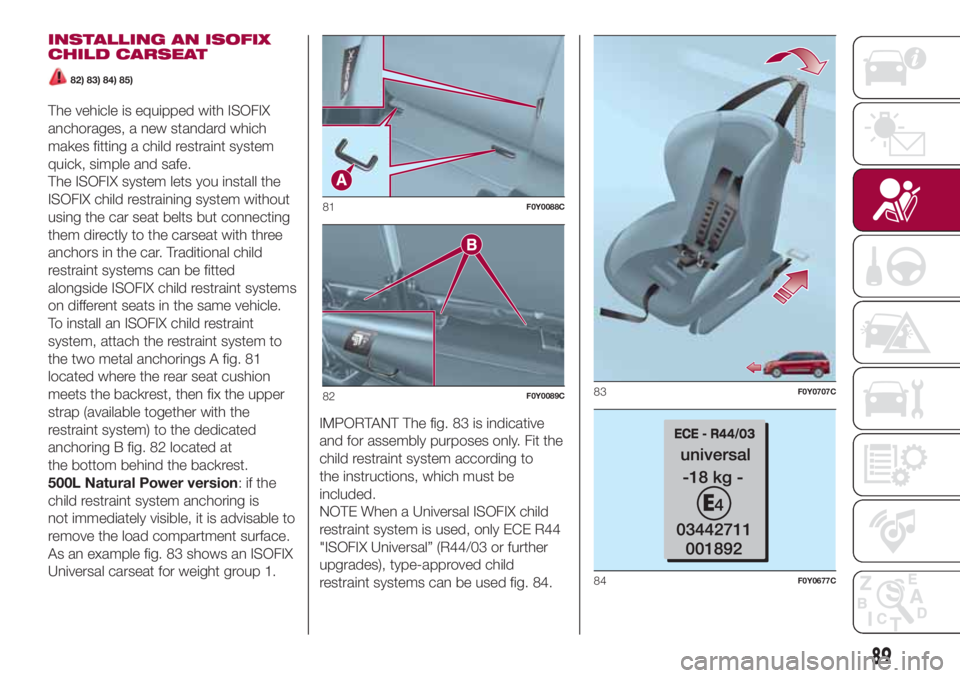
INSTALLING AN ISOFIX
CHILD CARSEAT
82) 83) 84) 85)
The vehicle is equipped with ISOFIX
anchorages, a new standard which
makes fitting a child restraint system
quick, simple and safe.
The ISOFIX system lets you install the
ISOFIX child restraining system without
using the car seat belts but connecting
them directly to the carseat with three
anchors in the car. Traditional child
restraint systems can be fitted
alongside ISOFIX child restraint systems
on different seats in the same vehicle.
To install an ISOFIX child restraint
system, attach the restraint system to
the two metal anchorings A fig. 81
located where the rear seat cushion
meets the backrest, then fix the upper
strap (available together with the
restraint system) to the dedicated
anchoring B fig. 82 located at
the bottom behind the backrest.
500L Natural Power version:ifthe
child restraint system anchoring is
not immediately visible, it is advisable to
remove the load compartment surface.
As an example fig. 83 shows an ISOFIX
Universal carseat for weight group 1.IMPORTANT The fig. 83 is indicative
and for assembly purposes only. Fit the
child restraint system according to
the instructions, which must be
included.
NOTE When a Universal ISOFIX child
restraint system is used, only ECE R44
"ISOFIX Universal” (R44/03 or further
upgrades), type-approved child
restraint systems can be used fig. 84.
81F0Y0088C
82F0Y0089C83F0Y0707C
84F0Y0677C
89
Page 92 of 268
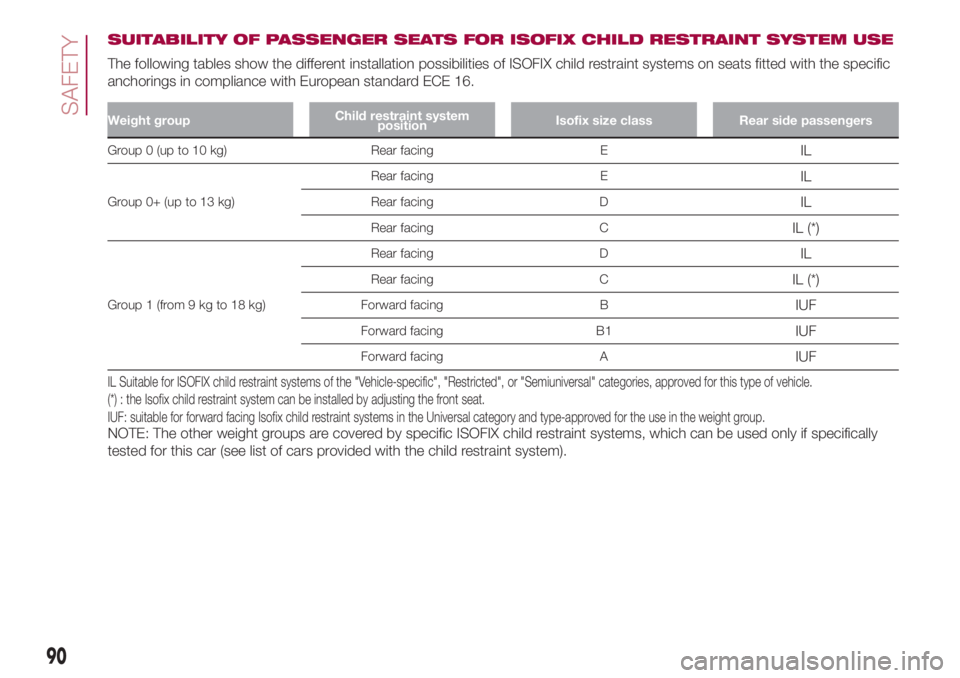
SUITABILITY OF PASSENGER SEATS FOR ISOFIX CHILD RESTRAINT SYSTEM USE
The following tables show the different installation possibilities of ISOFIX child restraint systems on seats fitted with the specific
anchorings in compliance with European standard ECE 16.
Weight groupChild restraint system
positionIsofix size class Rear side passengers
Group 0 (up to 10 kg) Rear facing EIL
Group 0+ (up to 13 kg)Rear facing E
IL
Rear facing DIL
Rear facing CIL (*)
Group 1 (from 9 kg to 18 kg)Rear facing D
IL
Rear facing CIL (*)
Forward facing BIUF
Forward facing B1IUF
Forward facing AIUF
IL Suitable for ISOFIX child restraint systems of the "Vehicle-specific", "Restricted", or "Semiuniversal" categories, approved for this type of vehicle.
(*) : the Isofix child restraint system can be installed by adjusting the front seat.
IUF: suitable for forward facing Isofix child restraint systems in the Universal category and type-approved for the use in the weight group.
NOTE: The other weight groups are covered by specific ISOFIX child restraint systems, which can be used only if specifically
tested for this car (see list of cars provided with the child restraint system).
90
SAFETY
Page 93 of 268
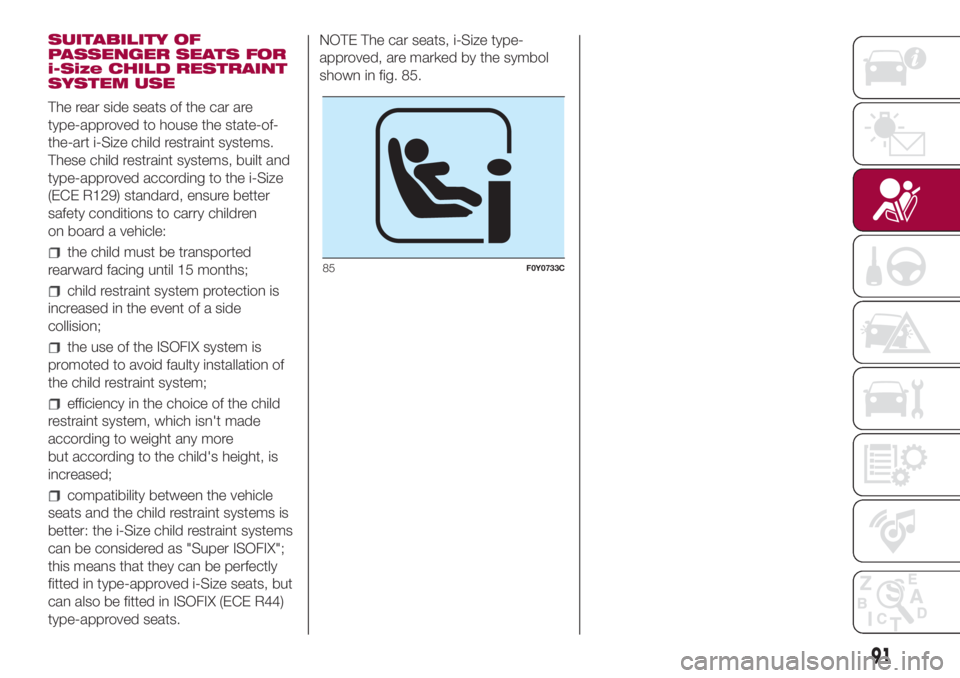
SUITABILITY OF
PASSENGER SEATS FOR
i-Size CHILD RESTRAINT
SYSTEM USE
The rear side seats of the car are
type-approved to house the state-of-
the-art i-Size child restraint systems.
These child restraint systems, built and
type-approved according to the i-Size
(ECE R129) standard, ensure better
safety conditions to carry children
on board a vehicle:
the child must be transported
rearward facing until 15 months;
child restraint system protection is
increased in the event of a side
collision;
the use of the ISOFIX system is
promoted to avoid faulty installation of
the child restraint system;
efficiency in the choice of the child
restraint system, which isn't made
according to weight any more
but according to the child's height, is
increased;
compatibility between the vehicle
seats and the child restraint systems is
better: the i-Size child restraint systems
can be considered as "Super ISOFIX";
this means that they can be perfectly
fitted in type-approved i-Size seats, but
can also be fitted in ISOFIX (ECE R44)
type-approved seats.NOTE The car seats, i-Size type-
approved, are marked by the symbol
shown in fig. 85.
85F0Y0733C
91
Page 94 of 268
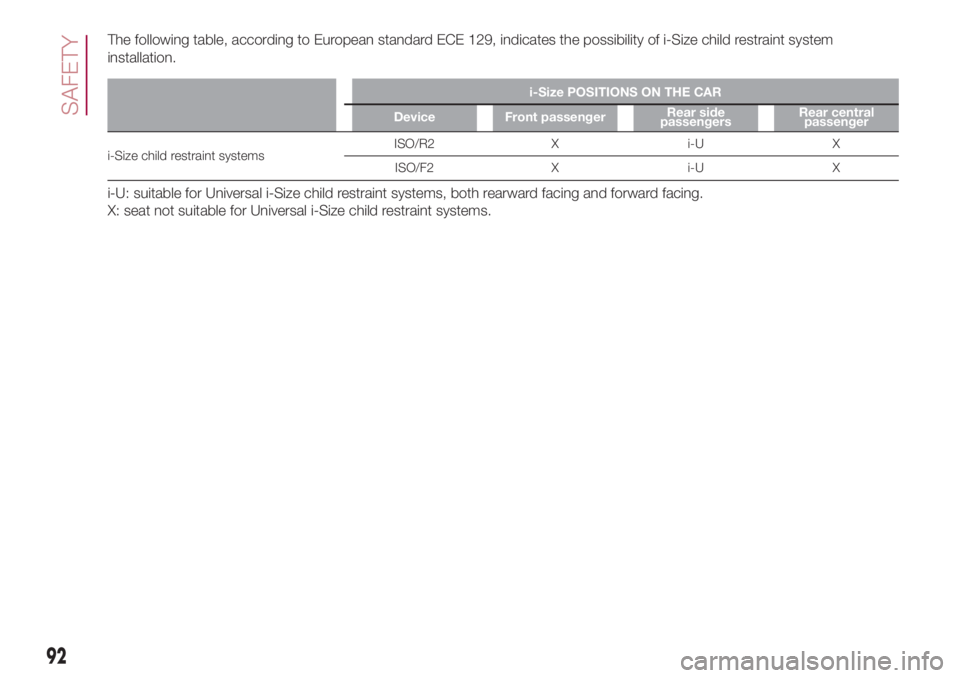
The following table, according to European standard ECE 129, indicates the possibility of i-Size child restraint system
installation.
i-Size POSITIONS ON THE CAR
Device Front passengerRear side
passengersRear central
passenger
i-Size child restraint systemsISO/R2 X i-U X
ISO/F2 X i-U X
i-U: suitable for Universal i-Size child restraint systems, both rearward facing and forward facing.
X: seat not suitable for Universal i-Size child restraint systems.
92
SAFETY
Page 95 of 268
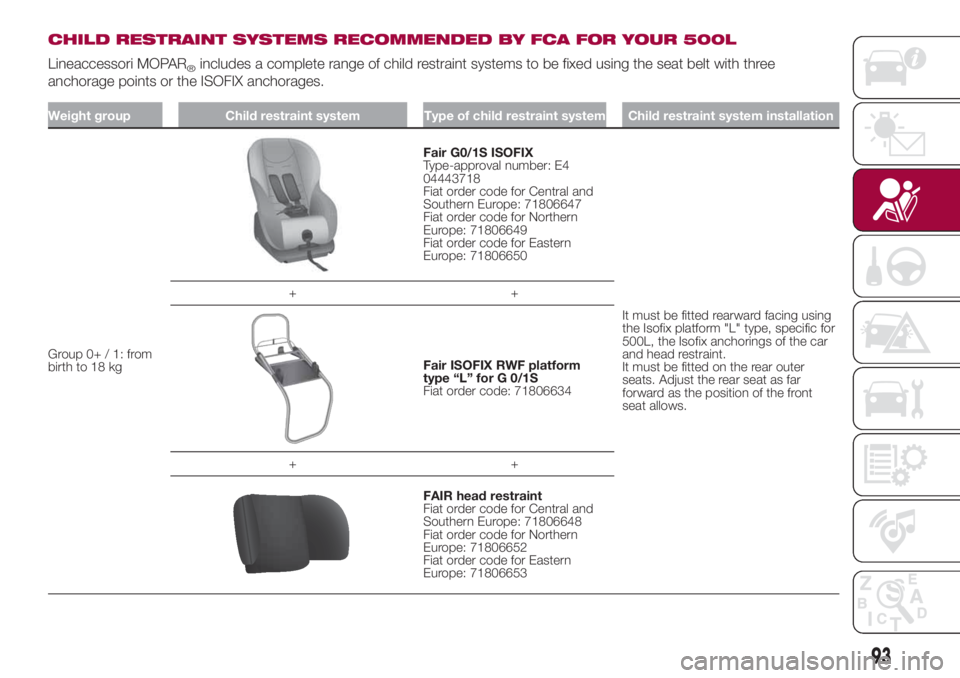
CHILD RESTRAINT SYSTEMS RECOMMENDED BY FCA FOR YOUR 500L
Lineaccessori MOPAR
®includes a complete range of child restraint systems to be fixed using the seat belt with three
anchorage points or the ISOFIX anchorages.
Weight group Child restraint system Type of child restraint system Child restraint system installation
Group 0+ / 1: from
birth to 18 kg
Fair G0/1S ISOFIX
Type-approval number: E4
04443718
Fiat order code for Central and
Southern Europe: 71806647
Fiat order code for Northern
Europe: 71806649
Fiat order code for Eastern
Europe: 71806650
It must be fitted rearward facing using
the Isofix platform "L" type, specific for
500L, the Isofix anchorings of the car
and head restraint.
It must be fitted on the rear outer
seats. Adjust the rear seat as far
forward as the position of the front
seat allows. ++
Fair ISOFIX RWF platform
type “L” for G 0/1S
Fiat order code: 71806634
++
FAIR head restraint
Fiat order code for Central and
Southern Europe: 71806648
Fiat order code for Northern
Europe: 71806652
Fiat order code for Eastern
Europe: 71806653
93
Page 96 of 268
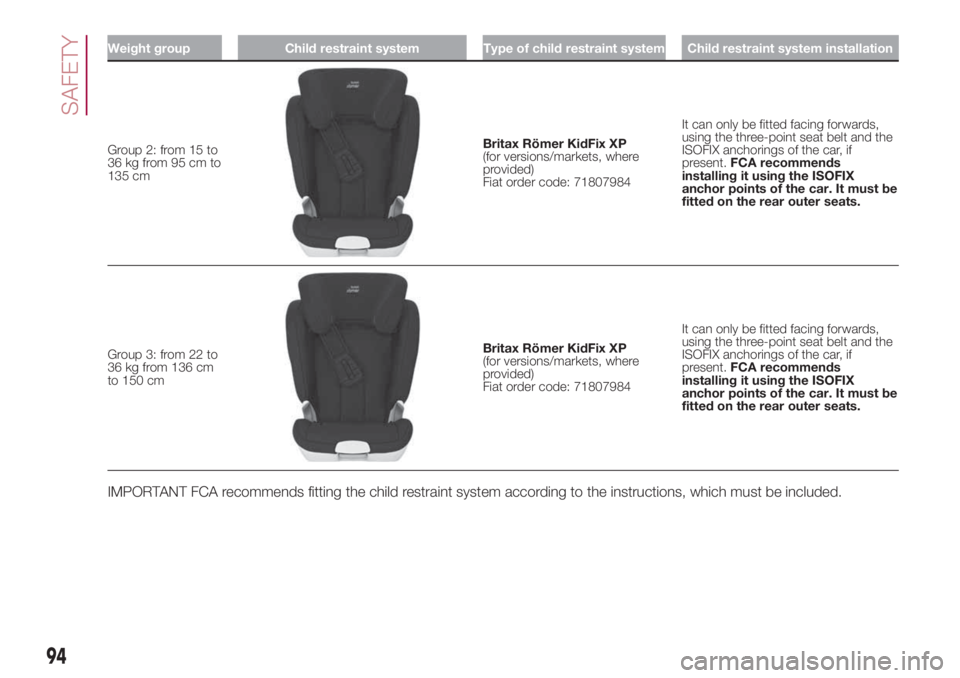
Weight group Child restraint system Type of child restraint system Child restraint system installation
Group 2: from 15 to
36 kg from 95 cm to
135 cmBritax Römer KidFix XP
(for versions/markets, where
provided)
Fiat order code: 71807984It can only be fitted facing forwards,
using the three-point seat belt and the
ISOFIX anchorings of the car, if
present.FCA recommends
installing it using the ISOFIX
anchor points of the car. It must be
fitted on the rear outer seats.
Group 3: from 22 to
36 kg from 136 cm
to 150 cm
Britax Römer KidFix XP
(for versions/markets, where
provided)
Fiat order code: 71807984It can only be fitted facing forwards,
using the three-point seat belt and the
ISOFIX anchorings of the car, if
present.FCA recommends
installing it using the ISOFIX
anchor points of the car. It must be
fitted on the rear outer seats.
IMPORTANT FCA recommends fitting the child restraint system according to the instructions, which must be included.
94
SAFETY
Page 97 of 268
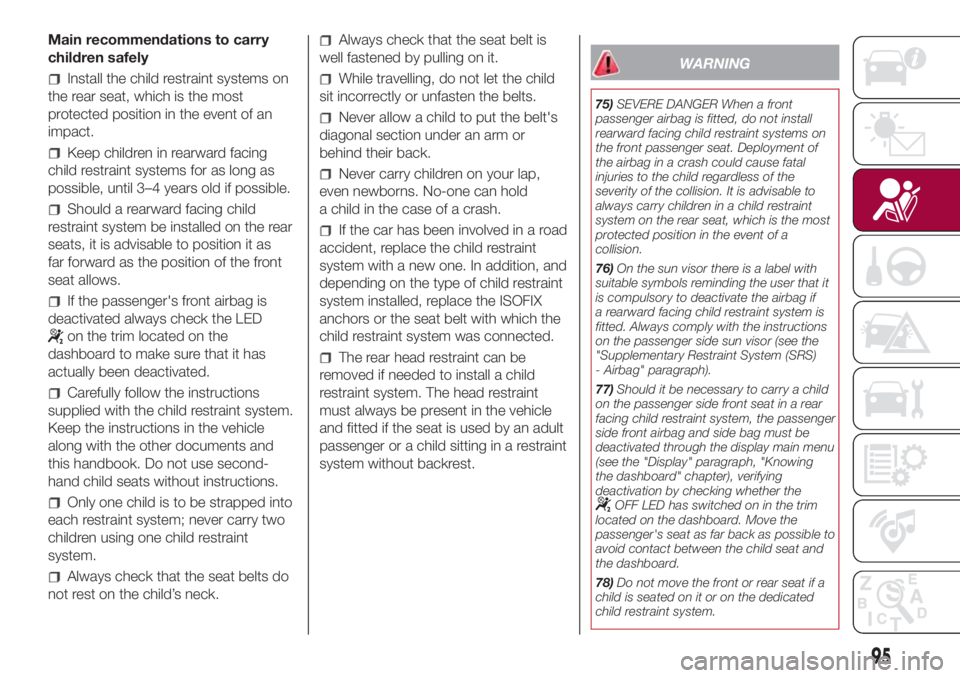
Main recommendations to carry
children safely
Install the child restraint systems on
the rear seat, which is the most
protected position in the event of an
impact.
Keep children in rearward facing
child restraint systems for as long as
possible, until 3–4 years old if possible.
Should a rearward facing child
restraint system be installed on the rear
seats, it is advisable to position it as
far forward as the position of the front
seat allows.
If the passenger's front airbag is
deactivated always check the LED
on the trim located on the
dashboard to make sure that it has
actually been deactivated.
Carefully follow the instructions
supplied with the child restraint system.
Keep the instructions in the vehicle
along with the other documents and
this handbook. Do not use second-
hand child seats without instructions.
Only one child is to be strapped into
each restraint system; never carry two
children using one child restraint
system.
Always check that the seat belts do
not rest on the child’s neck.
Always check that the seat belt is
well fastened by pulling on it.
While travelling, do not let the child
sit incorrectly or unfasten the belts.
Never allow a child to put the belt's
diagonal section under an arm or
behind their back.
Never carry children on your lap,
even newborns. No-one can hold
a child in the case of a crash.
If the car has been involved in a road
accident, replace the child restraint
system with a new one. In addition, and
depending on the type of child restraint
system installed, replace the ISOFIX
anchors or the seat belt with which the
child restraint system was connected.
The rear head restraint can be
removed if needed to install a child
restraint system. The head restraint
must always be present in the vehicle
and fitted if the seat is used by an adult
passenger or a child sitting in a restraint
system without backrest.
WARNING
75)SEVERE DANGER When a front
passenger airbag is fitted, do not install
rearward facing child restraint systems on
the front passenger seat. Deployment of
the airbag in a crash could cause fatal
injuries to the child regardless of the
severity of the collision. It is advisable to
always carry children in a child restraint
system on the rear seat, which is the most
protected position in the event of a
collision.
76)On the sun visor there is a label with
suitable symbols reminding the user that it
is compulsory to deactivate the airbag if
a rearward facing child restraint system is
fitted. Always comply with the instructions
on the passenger side sun visor (see the
"Supplementary Restraint System (SRS)
- Airbag" paragraph).
77)Should it be necessary to carry a child
on the passenger side front seat in a rear
facing child restraint system, the passenger
side front airbag and side bag must be
deactivated through the display main menu
(see the "Display" paragraph, "Knowing
the dashboard" chapter), verifying
deactivation by checking whether the
OFF LED has switched on in the trim
located on the dashboard. Move the
passenger's seat as far back as possible to
avoid contact between the child seat and
the dashboard.
78)Do not move the front or rear seat if a
child is seated on it or on the dedicated
child restraint system.
95
Page 98 of 268
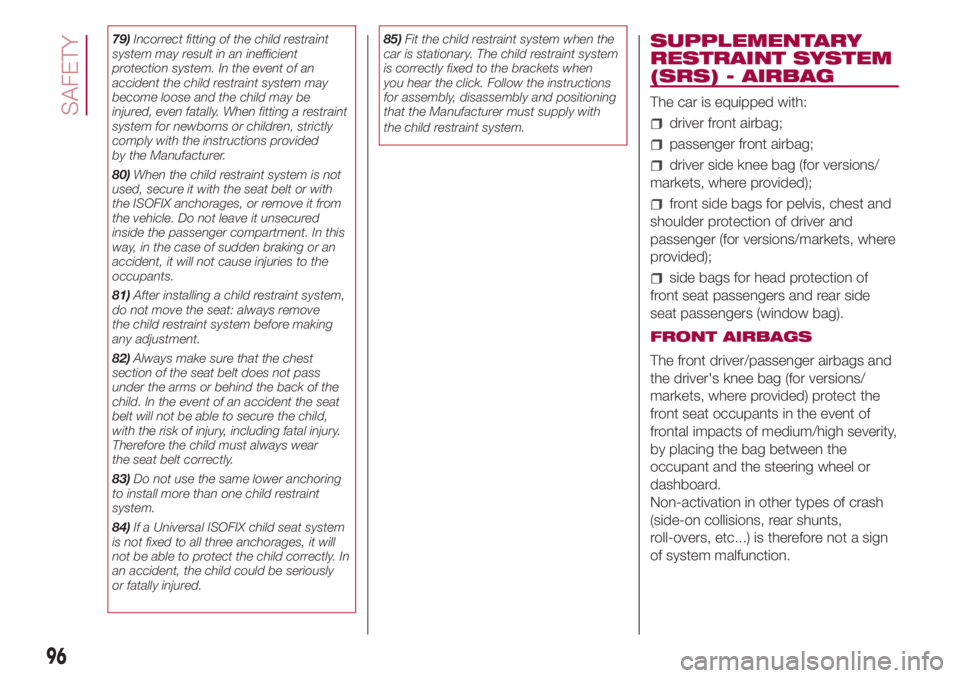
79)Incorrect fitting of the child restraint
system may result in an inefficient
protection system. In the event of an
accident the child restraint system may
become loose and the child may be
injured, even fatally. When fitting a restraint
system for newborns or children, strictly
comply with the instructions provided
by the Manufacturer.
80)When the child restraint system is not
used, secure it with the seat belt or with
the ISOFIX anchorages, or remove it from
the vehicle. Do not leave it unsecured
inside the passenger compartment. In this
way, in the case of sudden braking or an
accident, it will not cause injuries to the
occupants.
81)After installing a child restraint system,
do not move the seat: always remove
the child restraint system before making
any adjustment.
82)Always make sure that the chest
section of the seat belt does not pass
under the arms or behind the back of the
child. In the event of an accident the seat
belt will not be able to secure the child,
with the risk of injury, including fatal injury.
Therefore the child must always wear
the seat belt correctly.
83)Do not use the same lower anchoring
to install more than one child restraint
system.
84)If a Universal ISOFIX child seat system
is not fixed to all three anchorages, it will
not be able to protect the child correctly. In
an accident, the child could be seriously
or fatally injured.85)Fit the child restraint system when the
car is stationary. The child restraint system
is correctly fixed to the brackets when
you hear the click. Follow the instructions
for assembly, disassembly and positioning
that the Manufacturer must supply with
the child restraint system.SUPPLEMENTARY
RESTRAINT SYSTEM
(SRS) - AIRBAG
The car is equipped with:
driver front airbag;
passenger front airbag;
driver side knee bag (for versions/
markets, where provided);
front side bags for pelvis, chest and
shoulder protection of driver and
passenger (for versions/markets, where
provided);
side bags for head protection of
front seat passengers and rear side
seat passengers (window bag).
FRONT AIRBAGS
The front driver/passenger airbags and
the driver's knee bag (for versions/
markets, where provided) protect the
front seat occupants in the event of
frontal impacts of medium/high severity,
by placing the bag between the
occupant and the steering wheel or
dashboard.
Non-activation in other types of crash
(side-on collisions, rear shunts,
roll-overs, etc...) is therefore not a sign
of system malfunction.
96
SAFETY
Page 99 of 268
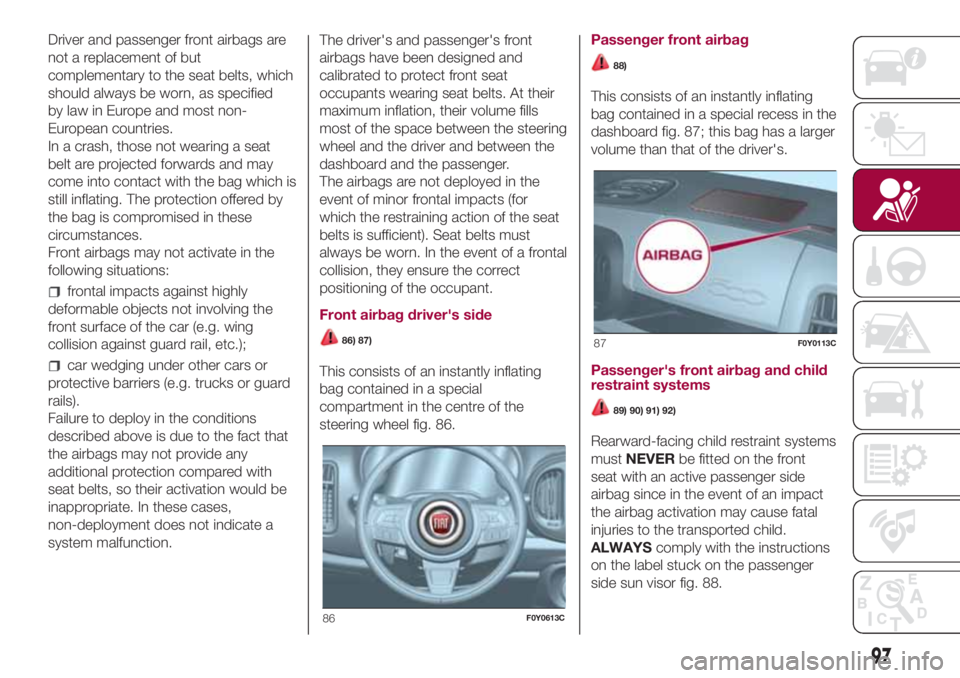
Driver and passenger front airbags are
not a replacement of but
complementary to the seat belts, which
should always be worn, as specified
by law in Europe and most non-
European countries.
In a crash, those not wearing a seat
belt are projected forwards and may
come into contact with the bag which is
still inflating. The protection offered by
the bag is compromised in these
circumstances.
Front airbags may not activate in the
following situations:
frontal impacts against highly
deformable objects not involving the
front surface of the car (e.g. wing
collision against guard rail, etc.);
car wedging under other cars or
protective barriers (e.g. trucks or guard
rails).
Failure to deploy in the conditions
described above is due to the fact that
the airbags may not provide any
additional protection compared with
seat belts, so their activation would be
inappropriate. In these cases,
non-deployment does not indicate a
system malfunction.The driver's and passenger's front
airbags have been designed and
calibrated to protect front seat
occupants wearing seat belts. At their
maximum inflation, their volume fills
most of the space between the steering
wheel and the driver and between the
dashboard and the passenger.
The airbags are not deployed in the
event of minor frontal impacts (for
which the restraining action of the seat
belts is sufficient). Seat belts must
always be worn. In the event of a frontal
collision, they ensure the correct
positioning of the occupant.
Front airbag driver's side
86) 87)
This consists of an instantly inflating
bag contained in a special
compartment in the centre of the
steering wheel fig. 86.Passenger front airbag
88)
This consists of an instantly inflating
bag contained in a special recess in the
dashboard fig. 87; this bag has a larger
volume than that of the driver's.
Passenger's front airbag and child
restraint systems
89) 90) 91) 92)
Rearward-facing child restraint systems
mustNEVERbe fitted on the front
seat with an active passenger side
airbag since in the event of an impact
the airbag activation may cause fatal
injuries to the transported child.
ALWAYScomply with the instructions
on the label stuck on the passenger
side sun visor fig. 88.
86F0Y0613C
87F0Y0113C
97
Page 100 of 268
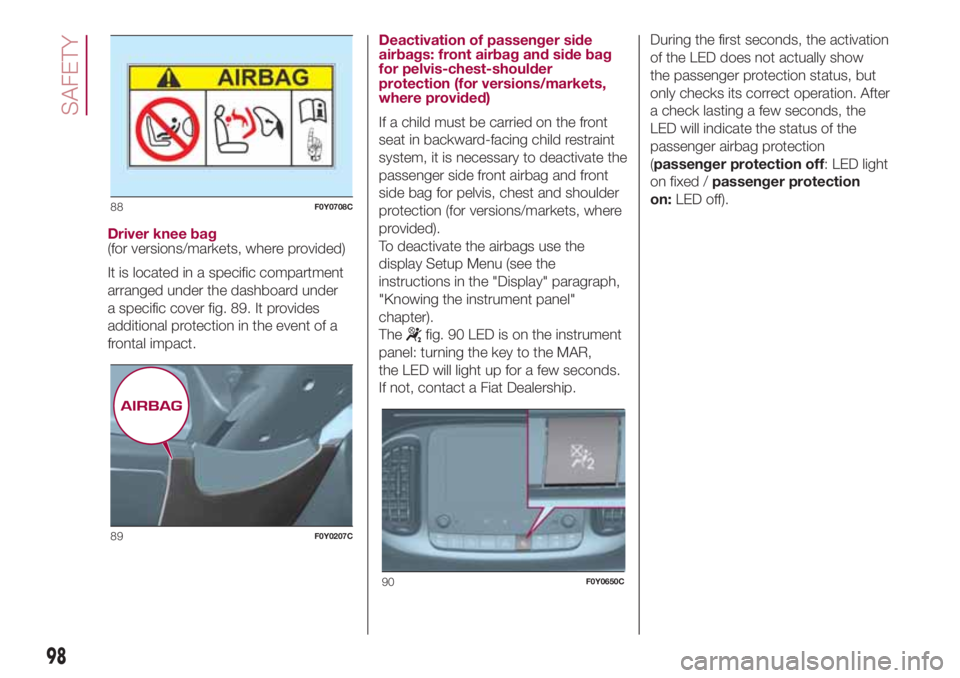
Driver knee bag
(for versions/markets, where provided)
It is located in a specific compartment
arranged under the dashboard under
a specific cover fig. 89. It provides
additional protection in the event of a
frontal impact.Deactivation of passenger side
airbags: front airbag and side bag
for pelvis-chest-shoulder
protection (for versions/markets,
where provided)
If a child must be carried on the front
seat in backward-facing child restraint
system, it is necessary to deactivate the
passenger side front airbag and front
side bag for pelvis, chest and shoulder
protection (for versions/markets, where
provided).
To deactivate the airbags use the
display Setup Menu (see the
instructions in the "Display" paragraph,
"Knowing the instrument panel"
chapter).
The
fig. 90 LED is on the instrument
panel: turning the key to the MAR,
the LED will light up for a few seconds.
If not, contact a Fiat Dealership.During the first seconds, the activation
of the LED does not actually show
the passenger protection status, but
only checks its correct operation. After
a check lasting a few seconds, the
LED will indicate the status of the
passenger airbag protection
(passenger protection off: LED light
on fixed /passenger protection
on:LED off).
88F0Y0708C
89F0Y0207C
90F0Y0650C
98
SAFETY